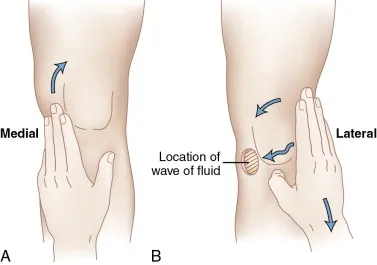Knee Effusion Clinical Tests
- Fysiobasen

- Oct 3
- 2 min read
Knee effusion refers to the accumulation of fluid within the knee joint due to irritation of the synovial membrane. The fluid may be:
Serous (synovial fluid)
Hemorrhagic (hemarthrosis, usually post-trauma)
Purulent (infection/septic arthritis)
The purpose of clinical tests is to confirm the presence of intra-articular effusion and differentiate it from soft tissue swelling or bony enlargement.

Clinical Relevance
Knee effusion typically presents as diffuse, symmetrical swelling, obscuring the normal contour of the knee. In subtle cases, effusion may only be detected by palpating the suprapatellar bursa.
Common causes include:
Osteoarthritis – chronic joint inflammation with fluid accumulation
Traumatic dislocation or ligament injury – acute hemarthrosis
Infection (septic arthritis) – serious condition with purulent effusion
Inflammatory arthritis – e.g., rheumatoid arthritis
Overuse injuries – repetitive strain
Tumors – rare cause of effusion
On palpation:
Synovial thickening feels firm
Clear effusion fluctuates fluidly
Hemarthrosis feels more gelatinous
Clinical Tests for Knee Effusion
1. Patellar Tap Test (Ballottement Patellae)
Purpose: Detects moderate effusion by determining if the patella floats on fluid.
Procedure:
Patient lies supine with extended knee
Examiner pushes fluid from suprapatellar pouch into the joint
Gentle downward pressure applied to patella
Interpretation:
Positive: Patella sinks then rebounds (“ballottement”)
Negative: Patella rests firmly against femur

2. Bulge / Wipe / Stroke Test
Purpose: Detects small effusions by observing fluid redistribution.
Procedure:
Patient supine with extended knee
Examiner strokes fluid upward along medial side, then downward along lateral side
Observe for fluid wave returning medially
Interpretation:
Positive: Visible fluid wave on medial knee
Negative: No visible fluid shift
Highly sensitive for subtle effusions not detectable by the patellar tap test.

3. Fluid Wave Test
Purpose: Detects small effusions (<30–50 ml).
Procedure:
Examiner compresses parapatellar gutters simultaneously
Patient rises while pressure is maintained
Release of pressure → observe fluid return
Interpretation:
Positive: Fluid visibly refills parapatellar recesses
Negative: No fluid return

4. Sweep Test
Purpose: Detects effusion by systematically moving joint fluid.
Procedure:
Examiner “sweeps” fluid across suprapatellar and medial recesses
Interpretation:
Positive: Observable shifting of joint fluid

Evidence and Reliability
Bulge sign – most reliable for detecting effusion (Rₐ = 0.97)
Balloon test – extremely high reliability (PABAK = 0.99)
Patellar tap test – best for moderate effusion
Stroke / Bulge / Fluid wave tests – most sensitive for small effusions
Conclusion
Clinical tests for knee effusion are effective in distinguishing between small, moderate, and large joint effusions:
Patellar Tap Test – best for moderate effusions
Bulge & Fluid Wave Tests – most sensitive for small effusions
Balloon Test – demonstrates highest reliability
For optimal diagnostic accuracy, these tests should be combined with a thorough clinical examination and, when needed, imaging studies to confirm diagnosis and guide management.









